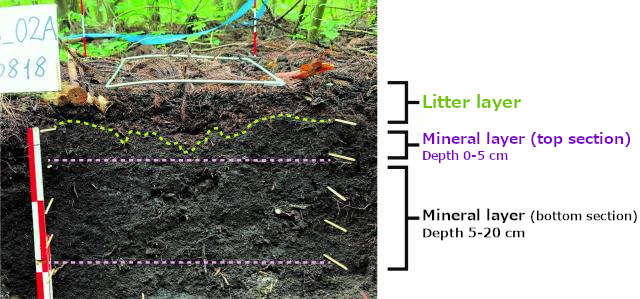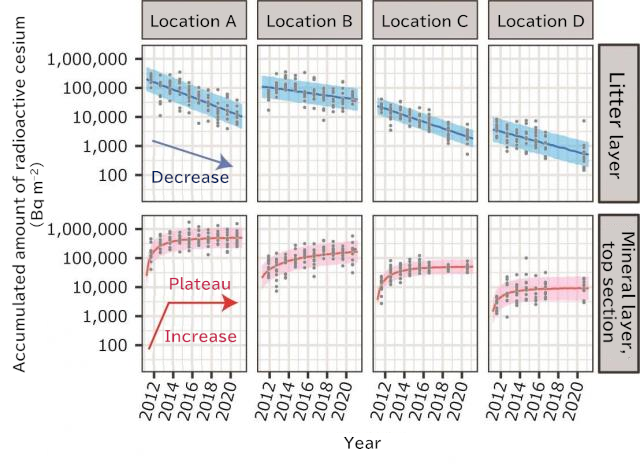Radioactivity Dynamics in forests
(2023)
QWhat kind of changes did radioactive cesium in forest soil contaminated by the nuclear accident go through over 10 years since the accident?
AThe Forestry and Forest Products Research Institute conducted a study for 10 years after the accident at the Fukushima Daiichi Nuclear Power Station to discover the distribution and movement of radioactive cesium (Cs-137) in forest soil. As a result, it was found that almost all radioactive cesium moved to the top section of the mineral layer over time, and now the movement has mostly stopped. This finding will contribute to implementing effective management of disaster-hit forests and predicting long-term dynamics of radioactive cesium.
In this study, the Forestry and Forest Products Research Institute (FFPRI) monitored a total of 10 forests predominantly inhabited with cedar, cypress, konara oak, or Japanese red pine, with different levels of contamination by the nuclear accident, in Kawauchi Village, Otama Village and Tadami Town, Fukushima, and in Ishioka City, Ibaraki. The monitoring continued from August 2011 on the concentration and accumulated amount of radioactive cesium in the litter layer and mineral layer (Figure 1).

Figure 1 Cross section of forest soil
As at 5 years after the accident, the amount of radioactive cesium accumulated in the litter layer showed a decreasing trend, while that in the top section of the mineral layer for the depth down to 5 cm showed an increasing trend. From that, it is expected that radioactive cesium that was present in the litter layer in the early stage after the accident moved to the top section of the mineral layer*1. Recently, the FFPRI conducted an analysis on the variations in the accumulated amount of radioactive cesium for a total of 10 years using multiple models, and found that the amount of radioactive cesium accumulated in the top section of the mineral layer stopped increasing and plateaued at many monitoring sites (Figure 2).

Figure 2 Variations in the amount of radioactive cesium accumulated in the litter layer and top section of mineral layer (depth of 0-5 cm) with time (showing results for cedar forests only)
The mark ● indicates measured values, and the lines and bands indicate the regression line and 80% confidence interval, respectively.
Recently, a report was made on the fact that radioactive cesium concentrations in wood in some forests stopped increasing or changed to decrease after continuing to increase for several years after the accident*2. Combined with that finding, the results in this study suggest that the amount of radioactive cesium absorbed into trees from soil via roots is balanced (in an equilibrium) with the amount of radioactive cesium fed to the soil from fallen leaves.
In addition, during the period of this study, no transfer of radioactive cesium from the top section to the bottom section (5-20 cm) of the mineral layer was observed. This is likely caused by clay minerals contained in the top section of mineral layer strongly immobilizing radioactive cesium.
The changes in the concentrations and accumulated amount of radioactive cesium shown above agreed with the forecast made by a model to predict the movement of radioactive cesium in forests proposed in the past*3. Radioactive cesium is likely to continue to stay in the top section of mineral layers over a long period of time in the future.
The long-term data on radioactive cesium in many sites obtained in this study are highly reliable and extremely valuable, and are expected to contribute to reviewing how to manage forests in the future and predicting the long-term dynamics of radioactive cesium in the world. On the other hand, circulation of radioactive cesium in forests (e.g., amount of radioactive cesium trees absorb from soil through their roots, amount of radioactive cesium trees give to soil through falling leaves) is unknown, and that needs to be elucidated by following studies to improve the prediction accuracy of radioactive cesium concentrations in forestry products. Still, there are many other unknown factors affecting the dynamics of radioactive cesium in the forest ecosystem, like why the accumulated amount of radioactive cesium and its changes vary from monitoring site to monitoring site. The FFPRI plans to continue the monitoring and research.
Notes
- *1 Radiocesium dynamics within forest ecosystems following the Fukushima Daiichi Nuclear Power Plant accident: migration of radiocesium from upper tree parts to the soil surface over 5 years (jumps to external website)
- *2 Q What kind of changes did radioactive cesium concentrations in wood and bark of trees contaminated by the nuclear accident go through over 10 years since the accident?
- *3 Q Will cesium distribution in forests continue to change in the future?
(Research results from the Forestry and Forest Products Research Institute and others. Reproduced from the website of the Forestry and Forest Products Research Institute (partly edited by JAEA))
Related articles
- I heard most of the forests would not be decontaminated. Does cesium remain in the forests?
- How does radioactive cesium in forests move from trees to the ground surface? 【Movement in throughfall, stemflow, and litterfall】
- How does radioactive cesium in forests move from trees to the ground surface? 【Movement as particulate and dissolved states】
